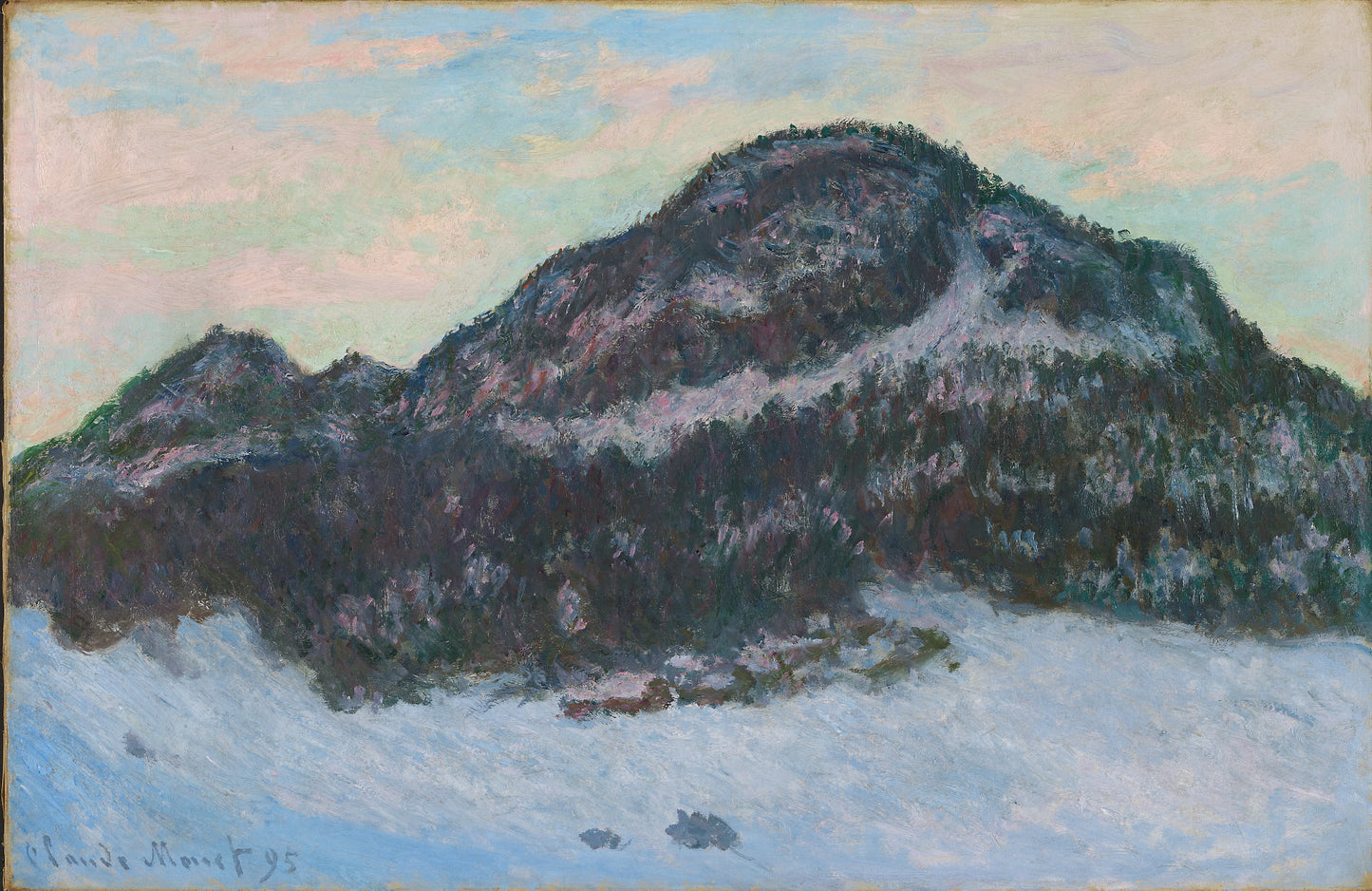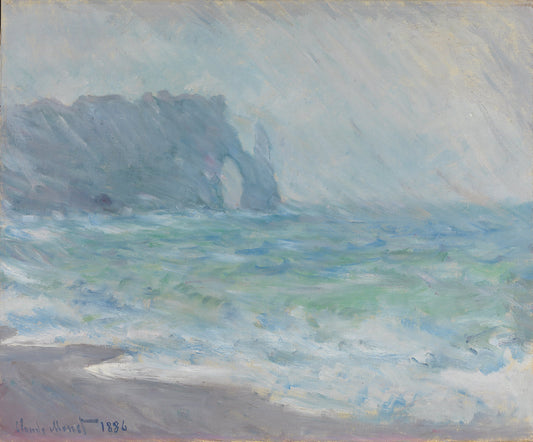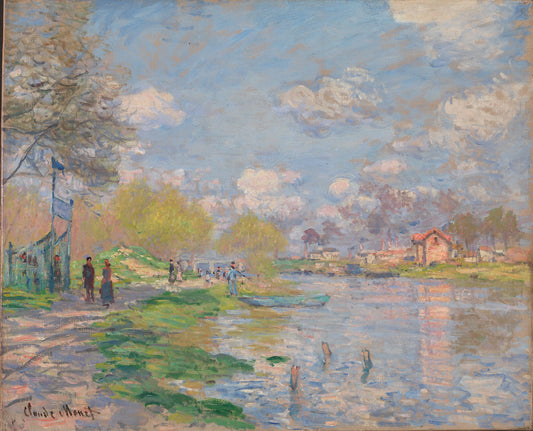Claude Monet
Kolsåtoppen
Kolsåtoppen
Couldn't load pickup availability
High-quality reproductions from the National Museum's collection. Posters by DAIDDA are printed on Litho White Matt - 230 gram photo paper in premium quality. Artprints by DAIDDA provide outstanding colors, sharpness and durability in museum quality - printed on Moab Entrada Natural 300 gram cotton art paper. Printed on a matte surface with scratch-resistant pigment ink.
About the original:
Date: 1895
Other titles: Mount Kolsås (ENG)
Designation: Painting
Material and technique: Oil on canvas
Technique: Oil
Material: Canvas
Dimensions: 65.4 x 100.5 cm
Subject: Visual arts
Classification: 532 - Visual arts
Type of motif: Landscape
Motif - place: Kolsås, Bærum
Acquisition: Deposited in the National Museum by the Sparebankstiftelsen DNB 2019
Inventory no.: NMK.DEP.2019.0010
Registration level: Single object
Owner and collection: Sparebankstiftelsen, Biledkunstsamlingene
Photo: Børre Høstland
Shipping and returns
Shipping and returns
Shipping: We deliver to Scandinavia, the EU, the USA and several other countries. Please contact us if your country is not listed and we will try to arrange delivery.
Delivery time: 2-5 days within Norway, 7 days in Europe, 14 days globally.
Packaging: Our products are made to order and sent rolled in environmentally friendly packaging.
Customs Fees: International orders may be subject to customs fees, which are not included in shipping costs.
Return policy: You can return images within 14 days. See our returns page for more information.
Secure Payment: We never store your payment details. See our privacy policy for details.

See all works
-
Kolsåtoppen
Vendor:Claude MonetRegular price From 150,00 NOKRegular priceUnit price per -
Rainy weather, Étretat
Vendor:Claude MonetRegular price From 150,00 NOKRegular priceUnit price per -
Printemps au bord de la Seine
Vendor:Claude MonetRegular price From 150,00 NOKRegular priceUnit price per

Claude Monet
Claude Monet was a world-famous painter and is considered one of the most central artists in Impressionism. He lived in Paris for a large part of his life, where impressionist visual art was current from the middle to the end of the 19th century.
Monet's painting style is characterized by thick, fast strokes with bright and clear colors. He avoided earth colors, ocher and black, in contrast to many other Impressionists. Monet's goal was to paint his impressions of the subject, preferably under special light and weather conditions. Monet was particularly interested in marine paintings, and his most famous works were painted in the coastal towns of Normandy and his own garden in Giverny. In his older days, the artist lived with the eye disease cataracts, and his idiom changed radically. In retrospect, the pictures from Monet's last period have also received great recognition. Growing up and early career Oscar-Claude Monet was born on 14 November 1840 in Paris. The family on both the mother's and father's side had established themselves there at the beginning of the 19th century. Oscar, as the family called him, was thus a true Parisian by birth. The Monet family first lived in simple conditions in Paris, but when Oscar was a small boy they moved to Le Havre. He was a charismatic schoolboy and became particularly popular among his classmates when he drew caricatures of teachers. One of those portrayed, François-Charles Ochard, had been a pupil of the history painter, Jacques Louis David. Ochard was Monet's drawing teacher around this time. Louise-Justine Monet was a musician, and the house in Le Havre was described as a festive and warm home.
Her death on 28 January 1857 created a great void in the Monet family. The 16-year-old Oscar left school that same summer and disagreed with his father about the way forward. Monet's aunt, Marie-Jeanne Lecadre, had recently been widowed and had no children herself. At Lecadre's urging, Monet was allowed to continue drawing with guidance from Ochard and other artists in the area. He earned good pocket money by selling the caricatures. In addition, Lecadre became one of Monet's most important supporters when he wanted to establish himself in the art world. Landscape painting Zoom in Pointe de la Heve at low tide, 1865 Monet's debut at the Salon was in 1865. He exhibited two works, hence the mouth of the Seine at Honfleur and Pointe de la Heve at low tide. It was only when Claude Monet was introduced to Eugène Boudin that he became involved in the art of painting. Following Boudin's teachings, Monet bought his first paint box and opened his eyes to painting "en plein air", i.e. outdoors. He was a patient and humble mentor and was credited by Monet as his most important artistic influence. The next step was to seek out the art scene in Paris. In 1859, Monet visited the artist Amand Gautier, who had exhibited at the renowned Salon de Paris and was one of Aunt Lecadre's contacts. Monet's first stay in Paris resulted in a few landscape paintings and many caricatures. Among other things, he was a frequent contributor to the illustrated wit magazine Le Charivari. War and independence After a few extravagant years in Paris, Monet received constant calls to return to Le Havre to work in the family business. In 1861 he was also a current candidate for military service. Monet wanted to take the opportunity to see the world and be free from his father's demands. He signed up for service and was deployed in Algeria. However, the military service turned out to be something other than what the artist had imagined. Monet had learned to ride during his service and seized the opportunity to hijack a donkey and escape from the camp. However, he was struck by illness on the journey and was laid off. The service ended with Monet being bailed out by his aunt in 1862. Thanks to her, he was able to continue focusing on art. When the Franco-German war broke out in 1870, Monet was in London. Here he met the art collector Paul Durand-Ruel, who became an essential financial contributor. He was also a driving force behind Monet's fame. Impressionism Zoom in The mouth of the Seine at Honfleur, 1865 Monet was particularly interested in marine paintings. The mouth of the Seine at Honfleur, 1865 By Claude Monet. License: Fell in the open (Public domain) During his leave, Monet had met the artist Johan Barthold Jongkind. He studied Jongkind's marine watercolors and received helpful advice from the painter.
When Monet went back to Paris, he brought with him landscape paintings from Le Havre and new inspiration. The road went on to the Academie Suisse and the teacher Charles Gleyre. At the academy he became acquainted with painters such as Pierre-Auguste Renoir, Alfred Sisley and Jean Frédéric Bazille. The latter became one of Monet's closest friends. Monet's debut at the Salon was in 1865. He exhibited two works: The Mouth of the Seine at Honfleur and Pointe de la Heve at Low Tide. Both paintings depicted the coast at Honfleur and received generally positive reviews. Incidentally, this was the same year that Édouard Manet created a furore with his contributions, which included the nude painting Olympia. Manet's acquaintance with Monet had an inauspicious start, partly because of their similar names. The indignant Manet received congratulations from cunning or ignorant audience members for Monet's contribution. When the two artists first met in 1866, a strong friendship nevertheless followed. Independent salons Zoom in Impression, sunrise Claude Monet's picture Impression. Soleil levant gave name to Impressionism. 1872, Musée Marmottan. Impression, Sunrise By Claude Monet. License: Fell in the open (Public domain) After 1866, Monet's contribution was rarely accepted for the annual exhibition. The Salon's jury also rejected entries from artists such as Paul Cézanne, Camille Pissarro, Renoir, Sisley and Bazille in 1867. Many of the rejected artists then exhibited at the alternative exhibition, the Salon des réfusés. Monet was also here for a few years, but missed a more serious exhibition platform. In 1873, Edgar Degas, Monet and Pissarro worked hard to bring together like-minded artists who sought away from classical painting styles. The first exhibition of the art association, Société anonyme coopérative d'artistes, was held in 1874. The title of the exhibition catalogue, Impression, also gave the nickname Impressionists to the artists who were part of the association. The title was inspired by Monet's painting Impression. Sunrise from 1873 - an iconic work from the port of Le Havre. Both fans and curious skeptics flocked to the exhibition. It was recognized as a breakthrough for independent artists in Paris. The exhibition also marked the shift from academic art to more individualistic artistic expressions. Family life Zoom in Camille or the woman in the green dress, 1866 In 1866 the painting Camille or the woman in the green dress was accepted as one of Monet's contributions to the salon's exhibition. It was the 19-year-old Camille-Léonie Doncieux who posed for the acclaimed photo. In 1866 the painting Camille or the Woman in the Green Dress was accepted as one of Monet's contributions to the Salon's exhibition. It was the 19-year-old Camille-Léonie Doncieux who posed for the acclaimed photo. She came from a middle-class family that had moved to Paris from Lyon. Camille became pregnant the following year, which presented challenges for a cash-strapped Claude. Jean Monet was born in 1868, but Camille and Monet did not officially marry until 1870.
Family life was a matter of getting used to, but Camille and Jean took part in all the trips in Europe as work opportunities presented themselves. The income was nevertheless very fluctuating during the 1870s, and the Monet family sometimes lived in cramped conditions in Paris. One of Monet's most persistent collectors was the merchant Ernest Hoschedé. He invited the artist to visit the Rottembourg castle where the Hoschedé family lived. Monet painted several paintings in the area in 1876. He had a fisherman's hut near the castle from summer to winter. Ernest was often away on business trips, and Monet developed a very close relationship with the family, especially the housewife Alice Hoschedé. Camille Monet became seriously ill in 1877. Despite her poor health, she became pregnant, and Michel Monet was born in March 1878. That same year, the Monet family moved to Vétheuil, where they shared a residence with the Hoschedé family as a result of ailing finances . But Camille Monet continued to deteriorate and died on 5 September 1879. After this, Jean and Michel Monet became an extended part of the Hoschéde family. Alice looked after the children while Monet traveled and worked. However, Monet and Alice's relationship was not recognized until after Ernest Hoschéde's death in 1891. The couple married on 16 July 1892.




